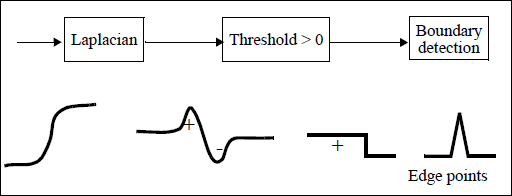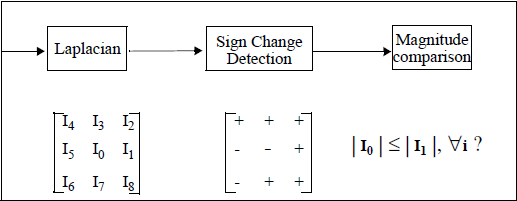Class SoZeroCrossingsProcessing2d
- java.lang.Object
-
- com.openinventor.inventor.Inventor
-
- com.openinventor.inventor.misc.SoBase
-
- com.openinventor.inventor.fields.SoFieldContainer
-
- com.openinventor.inventor.engines.SoEngine
-
- com.openinventor.imageviz.engines.SoImageVizEngine
-
- com.openinventor.imageviz.engines.edgedetection.edgemarking.SoZeroCrossingsProcessing2d
-
- All Implemented Interfaces:
SafeDisposable
public class SoZeroCrossingsProcessing2d extends SoImageVizEngine
SoZeroCrossingsProcessing2dengine. For an introduction to edge marking, see section Introduction to Edge Marking.Zero-crossings are points where the Laplacian switches from positive to negative values, and vice versa.
A simple zero-crossing detection is obtained by thresholding the Laplacian to retain positive intensities, then detecting the boundaries of the binary image, as in Figure 1. Such zero-crossing points are not precisely located.
 ZERO-CROSSINGS is even better to mark a point if the laplacian changes its sign in its 3x3 neighbourhood, and if the laplacian magnitude is smaller than all magnitudes in that neighbourhood, as in Figure 2.
ZERO-CROSSINGS is even better to mark a point if the laplacian changes its sign in its 3x3 neighbourhood, and if the laplacian magnitude is smaller than all magnitudes in that neighbourhood, as in Figure 2.
 Compared to thresholding of a gradient, zero-crossings have the advantage of producing closed curves of 1 pixel thickness. This is most interesting when precise object boundary detection is the goal.
Compared to thresholding of a gradient, zero-crossings have the advantage of producing closed curves of 1 pixel thickness. This is most interesting when precise object boundary detection is the goal.
File format/default:
ZeroCrossingsProcessing2d {
inImage NULL
Library references: zero_crossings
-
-
Nested Class Summary
-
Nested classes/interfaces inherited from class com.openinventor.imageviz.engines.SoImageVizEngine
SoImageVizEngine.ComputeModes, SoImageVizEngine.EventArg, SoImageVizEngine.Neighborhood3ds
-
Nested classes/interfaces inherited from class com.openinventor.inventor.Inventor
Inventor.ConstructorCommand
-
-
Field Summary
Fields Modifier and Type Field Description SoSFImageDataAdapterinImageThe input image.SoImageVizEngineOutput<SoSFImageDataAdapter,SoImageDataAdapter>outBinarylImageThe output binary image.-
Fields inherited from class com.openinventor.imageviz.engines.SoImageVizEngine
onBegin, onEnd, onProgress
-
Fields inherited from class com.openinventor.inventor.Inventor
VERBOSE_LEVEL, ZeroHandle
-
-
Constructor Summary
Constructors Constructor Description SoZeroCrossingsProcessing2d()Constructor.
-
Method Summary
-
Methods inherited from class com.openinventor.imageviz.engines.SoImageVizEngine
abortEvaluate, isEvaluating, startEvaluate, waitEvaluate
-
Methods inherited from class com.openinventor.inventor.engines.SoEngine
copy, getByName, getOutput, getOutputName
-
Methods inherited from class com.openinventor.inventor.fields.SoFieldContainer
copyFieldValues, copyFieldValues, enableNotify, fieldsAreEqual, get, getAllFields, getEventIn, getEventOut, getField, getFieldName, hasDefaultValues, isNotifyEnabled, set, setToDefaults
-
Methods inherited from class com.openinventor.inventor.misc.SoBase
dispose, getName, isDisposable, isSynchronizable, setName, setSynchronizable, touch
-
Methods inherited from class com.openinventor.inventor.Inventor
getNativeResourceHandle
-
-
-
-
Field Detail
-
inImage
public final SoSFImageDataAdapter inImage
The input image. Default value is NULL. Supported types include: grayscale binary label color image.
-
outBinarylImage
public final SoImageVizEngineOutput<SoSFImageDataAdapter,SoImageDataAdapter> outBinarylImage
The output binary image. Default value is NULL. Supported types include: binary image.
-
-